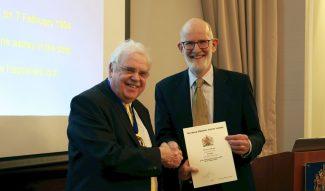The unusual collecting area of ‘The “Ocean Letter”’ was explained to the members of the Royal Philatelic Society London through a display and presentation given by Luc Selis of Belgium on 11 January. Luc described the procedure: ‘A passenger on board a cruise ship handed the message to be transmitted to the radio officer of the ship. As the ship was usually too far from any coastline, the message was transmitted wirelessly to a ship within range, sailing in the opposite direction. The radio officer of the receiving ship wrote or typed the message on a specially designed form, and placed it in an envelope. At the first port of call, the letter was handed over to the harbour post office for forwarding to the addressee.’ The system was introduced in 1911, the last usage being in 1957.
The process was illustrated with a wealth of documentation and covers that had been used to convey the messages. The forms used can be identified as they carried the heading ‘Ocean Letter’ or similar, such as ‘Ocean-Poste’, ‘Radio-Letter’, ‘Radiobrief’, ‘Radio Brev’ or ‘Ozeanbrief’.
Steven Harrison FRPSL, Honorary Secretary of the Society, giving the Vote of Thanks, likened the scheme to the saying ‘Ships that pass in the night’, adding that the display had brought together postal and social history.
President of the Society, Michael Roberts FRPSL, presenting Luc with a plaquette and certificate, added that he had provided a subject that was ‘different, and of which most were unaware’.






